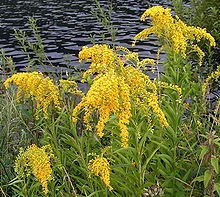Gardening with Allergies
You absolutely CAN grow, tend and enjoy a garden with allergies
It would be very difficult to eliminate the worst of the allergy aggravators from your landscape and gardens. But there are things you can do, and eliminate, and add to the gardens to help reduce exposure to allergy triggers.
Unfortunately some of the plants that can most aggravate allergies are grasses including bluegrass, and many of our staple trees including oak, maple and ash. But before you get out the chain saw and cover your property in pavers, figure out exactly what is triggering your symptoms. Spring, summer and fall produce different allergens. Perhaps it is tree pollen in spring, grass pollen in summer or weed pollen in fall aggravating your allergies. Paying attention to when you suffer most from allergies can help narrow down the offenders, which will help you to avoid the sneezing and itchy eyes. You will also be able to grow and care for your gardens and landscape differently if you know which plants are contributing to the problem. Keep in mind too, that plants that are pollinated by bees, birds and insects rather than wind born pollen will not be as likely to cause allergy symptoms.
What to grow:
Annual Geranium
Begonia
Clematis
Columbine
Crocus
Daffodil
Dahlia
Hibiscus
Hosta
Impatiens
Iris
Lilac
Lily
Pansy
Periwinkle
Petunia
Phlox
Salvia
Roses
Snapdragons
Tulips
Verbena
Zinnias
Azalea
Boxwood
English Yew
Hibiscus
Hydrangea
Viburnum
Apple Tree
Cherry Tree
Crepe Myrtle
Dogwood
English Holly
Magnolia
Pear Tree
Plum Tree
Red Maple
Redwood Tree
Where to grow:
Don’t plant window boxes, you will get a blast of pollen every time you open the windows.
Don’t plant pollen producers near entrance doors or windows
Perennial gardens can be positioned to be viewed well from your kitchen or living areas but at the outer areas of your landscape
What not to Grow:
If you are allergic to ragweed in fall, don’t plant sunflowers, daisies or mums, they are all related.
Goldenrod can trigger allergy symptoms
Johnson grass, Perennial rye grass, Timothy, Bermuda grass, bluegrass and fescue can all trigger allergies, but needless to say it is difficult to eliminate these. St. Augustine is one of the few grasses that are kind to allergy sufferers. The same goes for Maple trees, Oak, Ash, Birch, Olive, Hickory, Pine, Poplar, Willow, Cedar and Cottonwood trees. But at least with trees you can select something different. Shrubs are easy to make different selections, stay away from Cypress and Juniper shrubs.
What You Can Do Differently:
Take your allergy medication before you go outside.
Do your gardening early or late, midday the pollen counts are highest
After rain the pollen is washed of plants and wet pollen won’t blow around
Wear an allergy face mask, hat, glasses, gloves and long sleeves
Keep the grass short and see if someone else can mow it for you
Keep the windows closed when the grass is being mowed and for a few hours afterward
Do not plant dense hedges that can trap dust, mold and pollen
If you have mold allergies avoid moisture retaining mulch, use gravel, shells or plant groundcovers
Wash your hands frequently
Use an eye rinse when you come inside
Shower and wash your hair when you come inside or at least change your clothes and shower before bed to rid your hair and skin of allergens
Check pollen counts and skip gardening or yard work when they are high
Change furnace and air filters frequently, use a HEPA filter
So evaluate your gardening habits and the plants you are growing. Start planning some changes to your gardens and landscape, you will soon be enjoying more time in your garden.


